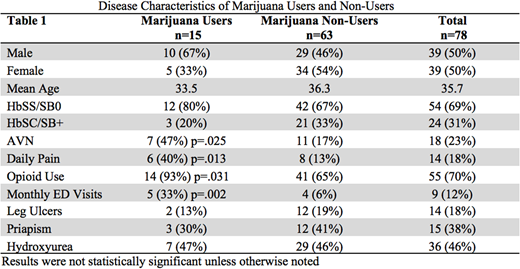Abstract
Background:
Opioid analgesics have served as the cornerstone of acute and chronic pain management in patients with sickle cell disease (SCD) in the United States. Despite significant opioid use, hospitalization for painful crises comprises the majority of healthcare costs for patients with SCD. Moreover, greater use of opioids may correlate with poorer response to treatment of acute painful crises. Insufficient pain management, the rise of opioid use disorder and opioid-related fatal overdose have opened the door for new strategies of pain management for these patients. Medical cannabis represents a potential new strategy for the management of chronic SCD pain. There is a substantial body of literature describing the analgesic properties of cannabis, but little research has explored its role in the management of SCD-related pain. We sought to evaluate the prevalence of marijuana use in an urban SCD patient population and to identify demographic and clinical characteristics that may predict marijuana use in this cohort.
Methods:
Adult patients with SCD seen at an urban outpatient SCD center completed an intake form with questions regarding individual demographics, cumulative disease complications, current or prior marijuana use, ED utilization, frequency of pain, and opioid use. Data from 78 patients seen between October 2017 and June 2018 were available for analysis. Additional data including information regarding disease genotype and race were collected from the electronic medical record. Data were analyzed using Microsoft Excel and Chi-Square analysis.
Results:
Among the 78 patients, mean age of the population was 35.7 years (range 20-69), and 50% were male. Genotype was 69% HbSS/SB0 and 31% HbSC/SB+. Twenty-three patients (29%) reported ever using marijuana, and 15 (19%) endorsed current use; most patients (80%) reported smoking. Marijuana users were more likely than non-users to be male (67% v 46%), to have HbSS/SB0 (80% v 67%), to have avascular necrosis (AVN) (47% v 17%, p=.025), to report daily pain (40% v 13%, p=.013), and to be prescribed opioids (93% v 65%, p=.031). Frequent ED visits (at least monthly) were more common in marijuana users (33% v 6% p=.002) compared to non-users. Age, leg ulcers, priapism, and hydroxyurea use were not different in users versus non-users.
Discussion:
In this cohort of patients with SCD seeking outpatient care, 19% reported current marijuana use for the management of SCD-related symptoms. Most patients reported smoking marijuana, and only one patient reported ingestion of edible marijuana. These rates are similar to marijuana use in other populations with chronic pain. SCD marijuana users were similar in age but not in sex distribution, as men more commonly reported marijuana use than women in our population. Marijuana users were enriched for the HbSS genotype, reported more daily pain, had more frequent ED visits and were more likely to be diagnosed with AVN of bones. There was a strong association between marijuana use and self-reported opioid use for pain control. These preliminary data suggest that patients with more severe manifestations of SCD, namely daily pain, frequent ED visits, AVN of bones, and significant utilization of opioids, are more likely to be using marijuana as adjunctive therapy for their chronic pain.
As of July 2018, 31 US states and the District of Columbia have legalized the use of medical cannabis, with chronic pain an indication in most states and opioid replacement an indication in some. The expansion of access to medical cannabis highlights the need for careful evaluation of the potential benefits and harms of medical cannabis in the SCD population. These benefits might include better control of daily pain, reduced visits to the ED, and possibly decreased utilization of opioids. As medical cannabis is becoming a more available therapy, carefully controlled prospective studies are needed to assess its efficacy in the management of debilitating symptoms of SCD.
Starrels:Opioid Post-Marketing Requirement Consortium: Other: Research and travel support from the Opioid Post-Marketing Requirement Consortium for a FDA-mandated observational study of the risks of opioid medications. Minniti:Novartis: Membership on an entity's Board of Directors or advisory committees; Bluebird Bio: Other: Adjudicating Committee; Global Blood Therapeutics: Research Funding; Teutona: Membership on an entity's Board of Directors or advisory committees; Bayer: Research Funding.
Author notes
Asterisk with author names denotes non-ASH members.


This feature is available to Subscribers Only
Sign In or Create an Account Close Modal